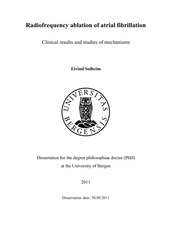| dc.contributor.author | Solheim, Eivind | en_US |
| dc.date.accessioned | 2012-01-06T10:40:46Z | |
| dc.date.available | 2012-01-06T10:40:46Z | |
| dc.date.issued | 2011-09-30 | eng |
| dc.identifier.isbn | 978-82-308-1839-8 (print version) | en_US |
| dc.identifier.uri | https://hdl.handle.net/1956/5363 | |
| dc.description.abstract | Introduction: Atrial fibrillation (AF) is the most common form of sustained cardiac arrhythmia. AF requires a trigger that initiates the arrhythmia, and the presence of a predisposing substrate that perpetuates it. Approximately 90% of paroxysmal AF episodes are initiated by triggers within the pulmonary veins (PVs), and the elimination of these foci, together with modification of the substrate, is the basis of most radiofrequency ablation (RFA) techniques. The aim of these studies was to illuminate various aspects of atrial fibrillation mechanisms, mapping and ablation methods, and clinical results. Methods: The patients in these studies had either symptomatic paroxysmal, persistent or long-standing persistent AF, and had failed to respond to at least one anti-arrhythmic drug. Patients underwent electrophysiological study and RFA in a fasting, sedated state. Vascular access was obtained, and after transseptal puncture, an irrigated-tip ablation catheter was used for mapping and ablation of the left atrium (LA) and for additional lines or focal ablation. In the course of this study, the techniques employed to achieve PV isolation evolved, and details of the isolation techniques involved at each stage are described in each paper. In the first study, complex fractionated atrial electrograms (CFAE) during AF were mapped in both atria. In the second, we specifically monitored the atrio-PV conduction delay (the shortest interval from local atrial electrogram to the PV potential) in each PV before and during ablation. In the third study, patients underwent either a conventional ablation procedure or a magnetic guided procedure with or without an irrigated catheter. Two cardiac biomarkers, troponin T (TnT) and cardiac creatine kinase (CKMB) were used to compare the myocardial injury created by the different catheters. In the next study, atrial volume calculations based on cardiac computed tomography were performed, and the cardiac biomarker N-terminal pro-brain natriuretic peptide (NT-pro-BNP) was measured, before ablation and at long-term follow-up. The final clinical follow-up study employed a qualityof- life questionnaire. Results and conclusions: CFAEs are preferentially distributed in specific areas in both atria. Persistent AF patients had more CFAEs than those with paroxysmal AF, and CFAEs were more widespread in both atria. Temporal signal stability also appeared to be higher in persistent AF. Atrio-PV conduction delay was more frequently observed in the left common PV and both of the superior PVs during PV isolation. Veins with focal activity displayed a higher incidence of conduction delay. The procedure and total ablation times were longer, and time-corrected release of TnT was higher, when the remote magnetic system was used in AF ablation. There was a statistically significant positive correlation between total ablation time and post-ablation levels of TnT and CKMB in all groups. LA volume and NT-pro-BNP levels fell only after successful AF ablation, and NT-pro-BNP correlated with LA volume both at baseline and follow-up. The arrhythmia burden also correlated with both NT-pro-BNP and LA volume. A decrease in NT-pro-BNP after RFA may be a marker of ablation success. AF may recur late, but most AF recurrences occurred within six months of the RFA procedure. | en_US |
| dc.language.iso | eng | eng |
| dc.publisher | The University of Bergen | eng |
| dc.relation.haspart | Paper I: Solheim E, Off MK, Hoff PI, Schuster P, Ohm O-J, Chen J. Characteristics and distribution of complex fractionated atrial electrograms in patients with paroxysmal and persistent atrial fibrillation. Journal of Interventional Cardiac Electrophysiology 28(2): 87-93, April 2010. Full text not available in BORA due to publisher restrictions. The article is available at: <a href="http://dx.doi.org/10.1007/s10840-010-9479-3" target="blank"> http://dx.doi.org/10.1007/s10840-010-9479-3</a> | en_US |
| dc.relation.haspart | Paper II: Off MK, Solheim E, Hoff PI, Schuster P, Ohm O-J, Chen J. Atrio-pulmonary vein conduction delay during pulmonary vein isolation for atrial fibrillation is related to vein anatomy, age and focal activity. Pacing and Clinical Electrophysiology 32(1): 207–210, March 2009. Full text not available in BORA due to publisher restrictions. The article is available at: <a href="http://dx.doi.org/10.1111/j.1540-8159.2008.02284.x" target="blank"> http://dx.doi.org/10.1111/j.1540-8159.2008.02284.x</a> | en_US |
| dc.relation.haspart | Paper III: Solheim E, Off MK, Hoff PI, De Bortoli A, Schuster P, Ohm O-J, Chen J. Remote magnetic versus manual catheters: evaluation of ablation effect in atrial fibrillation by myocardial marker levels. Journal of Interventional Cardiac Electrophysiology Volume 32(1): 37-43, April 2011. The article is available at: <a href="http://hdl.handle.net/1956/5222" target="blank"> http://hdl.handle.net/1956/5222</a> | en_US |
| dc.relation.haspart | Paper IV: Solheim E, Off MK, Hoff PI, De Bortoli A, Schuster P, Ohm O-J, Chen J. N-terminal pro-B-type natriuretic peptide level at long-term follow-up after atrial fibrillation ablation: A marker of reverse atrial remodeling and successful ablation. Journal of Interventional Cardiac Electrophysiology, in press. The article is available at: <a href="http://hdl.handle.net/1956/5364" target="blank"> http://hdl.handle.net/1956/5364</a> | en_US |
| dc.relation.haspart | Paper V: Solheim E, Hoff PI, Off MK, Ohm O-J, Chen J. Significance of late recurrence of atrial fibrillation during long-term follow-up after pulmonary vein isolation. Pacing and Clinical Electrophysiology 30(1): 108-111, January 2007. Full text not available in BORA due to publisher restrictions. The article is available at: <a href="http://dx.doi.org/10.1111/j.1540-8159.2007.00617.x" target="blank"> http://dx.doi.org/10.1111/j.1540-8159.2007.00617.x</a> | en_US |
| dc.title | Radiofrequency ablation of atrial fibrillation. Clinical results and studies of mechanisms | en_US |
| dc.type | Doctoral thesis | |
| dc.rights.holder | Copyright the author. All rights reserved | |
| dc.subject.nsi | VDP::Medical disciplines: 700::Clinical medical disciplines: 750::Cardiology: 771 | eng |
